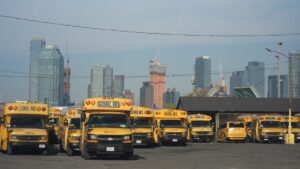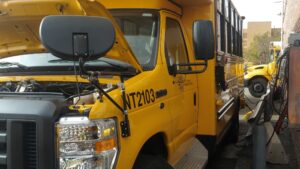The Electric School Bus: Drive to Future
By Ruonan Jiang
Lauren Kesner O’Brien’s daughter, Alea, is applying to a high school in Manhattan where she will take a school bus to commute. Reflecting on Alea covering her nose and frowning after walking behind diesel exhaust, O’Brien worries about whether the school transportation would harm her daughter’s health in the pursuit of education. “A lot of my children’s friends have asthma, and they’re just exposed to a lot of vehicle emissions walking around the city,” she says. “School buses seem particularly poignant because they are made to protect kids, take kids to school. At minimum they should be clean.”

Alea covers her nose because of diesel exhaust. Photo by Ruonan Jiang.
In New York State, more than 2 million students ride school buses every year. Around 50,000 school buses, which is 10% of the nation’s fleets, are used to transport children safely. However, since most of them are diesel-powered vehicles, they emit greenhouse gases including CO2 that not only contribute to global warming but also have adverse effects on children’s health. According to the American Lung Association, long-term exposure to air pollutants such as particulate matter, which also can be produced from diesel exhaust, increases the risk of developing respiratory diseases such as asthma and reduced lung, heart, and brain growth.
To avoid environmental degradation and to improve the living quality of future generations, advocates and politicians are urgently seeking solutions. In 2022, New York State passed legislation that would mandate all school buses be switched to zero-emission vehicles by 2035, and all bus fleets that are sold in the state be zero-emission by 2027. The goal aligns with New York State’s Climate Act, which seeks to reduce the state’s greenhouse gas emissions 80% by 2050.
While school districts, bus companies, and contractors are slowly adapting to the transition and putting the law into action, many organizations are offering support. The president of the New York League of Conservation Voters, Julie Tighe, believes the organization needs to help “children who are just trying to go to school where they can learn, and it’s often hard if we send them to school in a vehicle that’s making them sick.”
As the CEO of NYC School Bus Umbrella Services (NYCSBUS), a nonprofit that operates about 850 school bus routes throughout the five boroughs in the city, Matt Berlin feels that passing the bill is not enough, and it is urgent to implement the state’s mandate. In late 2022, his company partnered with NYLCV, WRI, Bronx Community College, CALSTAR, and the Mobility House to launch the project “Electrifying School Buses in Bronx and Beyond,” which received $8 million in funds from New York State Energy Research Development Authority (NYSERDA). The project serves as a case study for other school districts and bus contractors, and the investment will be distributed in the purchase of electric school buses, the laying out of charging infrastructure, and training mechanics and workers in the Zerega depot in the Bronx to adapt to electric school buses.

School buse fleets in NYCSBUS. Photo by Ruonan Jiang.
“The area around this particular depot is at 98 percentile of air pollution, which means it’s very very high,” Tighe adds. “We wanna show it can be done in a very dense urban neighborhood in a way that is beneficial not just for kids who are riding the school bus, but also for the neighborhood around it.”
Working class neighborhoods in the Bronx are exposed to disproportionately high levels of air pollution. According to the New York City Health Department’s Epi Data Report, children in the Bronx have been experiencing high rates of asthma-related medical visits and hospitalizations for years compared to other boroughs in the city. The transition to electric school buses in the Bronx aims to reduce air pollution that is largely caused by heavy-duty traffic and decrease the risk of health concerns for children.
Further research shows air pollution is also associated with high rates of premature deaths, heart disease, and even psychiatric issues. Trevor Summerfield, the advocacy director for the American Lung Association in NY and Vermont, wishes more health organizations such as the Cancer Society and Heart Association could engage in the argument and draw the public’s attention. “We have to take other health people to the table to make sure other people know that it’s not just us that are concerned with this issue, that is the whole [health] community,” Summerfield says.
Implementation of the law will be challenging. Installation of charging infrastructure and the cost of electric vehicles are two main concerns, and Berlin says he is prepared to address them. “Even if there are challenges and costs for the future, it’s better to know them upfront,” he says.
To ensure that electric school bus fleets operate smoothly, more charging stations have to be built, which takes time and costs money. NYCSBUS is working with the Mobility House to use the software “ChargePilot” to manage electricity and establish data connections between charging stations. They have received approval from ConEd to optimize energy usage and avoid overstressing the grid. Furthermore, Joint Utilities of New York, which comprises Central Hudson Gas & Electric Corporation, NYSEG, ConEdison, and three other utility companies, offers “incentives of up to 90% of utility-side infrastructure costs” that school bus companies can apply to.
Regarding the cost of electric buses, Tighe believes educating people about the available funds and support is important. For example, there are different options for transmitting a diesel power bus to electric vehicles, and retrofitting buses may be less expensive than purchasing new ones. Different grants from the state and the federal level are provided for school districts and bus contractors. New York State announced $100 million in funds to help achieve the mandate of electrifying all school buses, and the first-round application was opened on Nov. 29.
Changing to electric school buses is a difficult and long process, but there are many ways to approach it. “People are a little uncomfortable because they aren’t familiar with it, but that’s part of being human, and we’re moving in the right direction,” Summerfield says.
Summerfield hopes knowing that electric school buses can be feasible and durable will alleviate concerns over this transition. “Did you ever take a school bus as a kid? You remembered that smell, like the seats, the diesel. That wasn’t there, and it was amazing.” He remembered driving an electric school bus once in Albany, “and they were so quiet.” According to a bus driver in NYCSBUS, it usually takes two to eight hours to charge a school bus, depending on the capacity of the charger, and a fully charged electric school bus can run more than 100 miles. Based on WRI’s “Electric school bus U.S. market study” in 2022, electric school buses can run up to 210 miles depending on different manufacturers and companies.
Since electric school buses are purchased by some school districts and bus contractors separately, there is no current data about the exact number of electric buses that are already in operation around the state. NYCSBUS now has three electric school buses in the Zerega depot, 25 on order and waiting for delivery, with more to come. “Just this week we’ve been laying out our depots and showing that we’re gonna need 33-40% more space because of charges. That presents a number of challenges,” Berlin says. He is also concerned that almost two thirds of their school bus routes may need midday charging. “It’s not a reason not to drive; it’s not a reason to slow down. But it’s important to know ahead of 2035 so we can plan for it.”

Electric School Bus in NYCSBUS. Photo by Ruonan Jiang.
While advocates, school bus operators, and politicians are inching their way toward the future where all school buses can be zero-emission, Tighe believes newfound urgency is needed. “Clean air is not a partisan issue. Everyone wants to breathe clean air; they want their kids to breathe healthy air. They don’t want their kids to be sick because of the bad air quality coming from the school bus as they are just trying to learn.”
Now O’Brien is an activist and a member of the New York City School Bus Coalition, which was started by NYLCV and some other environmental organizations to advocate for electric school buses. She also works as a Policy and Partnerships Manager in Empire Clean City (ECC), a non-profit organization that is committed to advancing cleaner air and energy. “As a parent, it was just a clear connection with my children and their future,” she says. “In the next two years, we’re supposed to have, I believe, 75 school buses, and we don’t yet. So the NYC School Bus Coalition is trying to keep this issue at the forefront so that we can remind elected officials of these promises and try to support the implementation.”